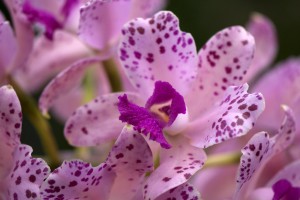Tip of the Week: Repotting Orchids—Making a Mix
Posted in Gardening Tips on March 8 2010, by Sonia Uyterhoeven
 |
Sonia Uyterhoeven is Gardener for Public Education. For hands-on demonstrations and orchid tips, join her in the Conservatory’s GreenSchool every Saturday and Sunday at 2 p.m. throughout The Orchid Show. |
 Part 1 of 3-part series
Part 1 of 3-part series
A few weeks ago, I spent a quiet afternoon at the Nolen Greenhouses with my colleague Fintan O’Sullivan repotting orchids. We started by preparing a free-draining mix for Cattleyas.
A large bag of coarse Douglas fir bark (white fir bark is also used) was spread out on the potting bench. Fintan then filled an empty crate first with horticultural charcoal and then with coarse perlite. The crate served two purposes: measurement (the contents amounted to about one-third to half the quantity of the bark chips) and as a temporary free-draining container.
Both horticultural charcoal and perlite are very dusty and are much easier to work with if hosed down. We did this and then dumped the wet charcoal and perlite onto the pile of fir bark. With an old square shovel, we turned the material three times to mix it.
The best way to evenly blend a potting mixture is to clear an empty space on one side of the mound on the potting bench and with a shovel or scoop turn small strips or sections as you move along the pile. Scoop up the material by pushing the shovel from the front of the mound to the back, and then turn over the mix to the empty space at the side of the mound. As it is emptied, the shovel is drawn forward so that the mix spreads evenly over the space. Back and forth you go up and down the pile until you have a nice even blend.
Before we move on to actually repotting the orchid, let’s take a look at the mix’s ingredients. Fir bark is a common tool of the trade. All serious orchid growers are well versed in the merits of fir bark, which is generally made from Douglas fir. Eco-warriors can sleep well tonight—the bark chips are a byproduct of the logging industry, so no trees are cut down specifically so that your favorite epiphytes can live (that would be ironic!).
Bark comes in fine, medium, and coarse grades. The grade you choose is dependent on the growing requirements of your orchid. Orchids that require good drainage and like to approach dryness before watering generally thrive with a medium to coarse grade.
Charcoal and perlite are added to improve drainage even further. Charcoal also acts as a filter and keeps harmful fertilizer salts away from sensitive young roots. The three combined create a formidable trifecta for good drainage. Next week, we will talk about other preparations needed before repotting.


im very much looking forward to the other 2 :)